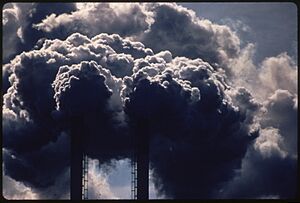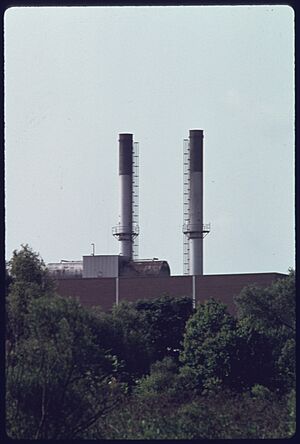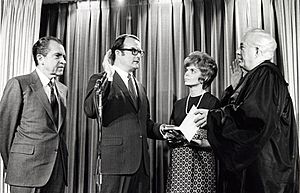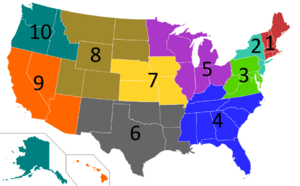United States Environmental Protection Agency facts for kids

Seal
|
|
Logo
|
|
 Flag |
|
| Agency overview | |
|---|---|
| Formed | December 2, 1970 |
| Jurisdiction | United States federal government |
| Headquarters | William Jefferson Clinton Federal Building Washington, D.C., U.S. 38°53′38″N 77°01′44″W / 38.8939°N 77.0289°W |
| Employees | 14,581 |
| Annual budget | $9,559,485,000 |
| Agency executives |
|
The Environmental Protection Agency (EPA) is a special agency of the United States government. Its main job is to protect our environment. President Richard Nixon suggested creating the EPA on July 9, 1970. It officially started working on December 2, 1970.
The EPA is led by an Administrator. The President chooses this person, and the Senate must approve them. The current Administrator is Michael S. Regan. The EPA's main office is in Washington, D.C.. There are also ten regional offices and 27 laboratories across the country.
This agency studies the environment, does research, and teaches people about protecting nature. It makes sure that national rules about the environment are followed. These rules come from different environmental laws. The EPA works with state and local governments to do this.
The EPA can give out fines or other punishments if rules are broken. It also lets states and Native American tribes help with some of its duties. The agency works with businesses and governments to prevent pollution. They also encourage efforts to save energy.
In 2023, the EPA had over 16,000 employees. Many of them are engineers, scientists, and environmental specialists. Others work in law, public relations, and finance.
How the EPA Started
Why Was the EPA Created?
In the late 1950s and 1960s, people in the United States became more worried about how human actions affected the environment. In 1959, Senator James E. Murray suggested a bill to create a Council on Environmental Quality. This bill did not pass, but its ideas were used later.
A very important book called Silent Spring came out in 1962. It was written by Rachel Carson. This book told people about the harmful effects of using too many pesticides on animals and humans. This made the public even more aware of environmental problems.
Leaders in Congress talked about solutions. In 1968, they held a meeting to discuss the need for a national environmental plan.
Finally, President Nixon's government made the environment a top priority. In 1970, President Nixon signed the National Environmental Policy Act (NEPA) into law. This law created the Council on Environmental Quality (CEQ). NEPA also required that big federal projects study their environmental impact. This study is called an environmental impact statement (EIS).
Setting Up the EPA
On July 9, 1970, President Nixon suggested a plan to bring many government environmental programs together. This new agency would be the Environmental Protection Agency. For example, programs dealing with pesticides from different departments would join the EPA.
Both the House and Senate approved this idea. The EPA officially opened on December 2, 1970. The first Administrator, William Ruckelshaus, started his job on December 4, 1970.
The EPA took over programs from several older agencies. These included parts of the U.S. Public Health Service that dealt with air pollution, solid waste, and water hygiene. It also took on programs from the Department of the Interior and the Food and Drug Administration.
When it started, the EPA had 84 offices and laboratories. They later combined these into 22 main locations.
EPA's Work Through the Years
The 1970s: New Laws and Big Changes
In its first year, the EPA had a budget of $1.4 billion and 5,800 employees. At first, the EPA mostly offered technical help and set goals. Soon, new laws gave the agency more power to make and enforce rules.
A big update to the Clean Air Act happened in December 1970. This law helps control air pollution. People working at the EPA felt a strong sense of purpose. They were excited to help solve the country's pollution problems.
Many people in the private sector thought environmental protection was just a passing trend. The first Administrator, William Ruckelshaus, felt pressure to show that the EPA could really make a difference.
A river in Cleveland, Ohio, the Cuyahoga River, caught fire in 1969. This caused a national outcry and led to legal action against big steel companies. In 1972, Congress passed the Clean Water Act (CWA). This law set up national rules for water quality. The EPA works with states to make sure these rules are followed.
In 1972, the Federal Insecticide, Fungicide, and Rodenticide Act (FIFRA) was updated. This law required the EPA to weigh the risks of pesticides against their benefits.
In 1973, President Nixon appointed Russell E. Train as the next EPA Administrator. In 1974, Congress passed the Safe Drinking Water Act. This law made the EPA create national standards for all public water systems. These systems provide water to most of the U.S. population.
In 1976, Congress passed the Toxic Substances Control Act (TSCA). This law gave the EPA power to collect information on chemicals. It also allowed the EPA to regulate how chemicals are made and used. The EPA had to create a list of all chemicals used in the country.
Also in 1976, Congress passed the Resource Conservation and Recovery Act (RCRA). This law updated how the country deals with waste. It tasked the EPA with setting goals for waste disposal. It also aimed to save energy and natural resources. The EPA developed rules for solid and hazardous waste.
President Jimmy Carter appointed Douglas M. Costle as EPA Administrator in 1977. By the end of 1979, the EPA's budget grew to $5.4 billion. Its workforce increased to 13,000 employees.
The 1980s: Challenges and Recovery
In 1980, after many dangerous waste sites like Love Canal were found, Congress passed the "Superfund" law. This law is officially called the Comprehensive Environmental Response, Compensation, and Liability Act. It allowed the EPA to find who was responsible for polluted sites. It also created a way to fund the cleanup of these sites.
In 1981, President Ronald Reagan appointed Anne Gorsuch as EPA Administrator. She believed the EPA was too big and regulated businesses too much. During her time, she cut the EPA's budget and reduced the number of cases against polluters.
Many environmental groups felt her policies were designed to help polluters. She faced problems with Congress and resigned in 1983. President Reagan then appointed William Ruckelshaus to be EPA Administrator again. He worked to bring back public trust in the agency.
Lee M. Thomas became Administrator in 1985. In 1986, Congress passed the Emergency Planning and Community Right-to-Know Act. This law allowed the EPA to collect data on toxic chemicals and share it with the public. The EPA also studied the problem of the ozone layer getting thinner.
In 1988, George H. W. Bush talked a lot about environmental issues during his presidential campaign. After he won, he appointed William K. Reilly, an environmentalist, as EPA Administrator in 1989. Under Reilly, the EPA started voluntary programs. They also began to focus more on local environmental issues.
The 1990s: New Partnerships and Programs
In 1992, the EPA and the Department of Energy started the Energy Star program. This program helps encourage energy efficiency.
Carol Browner was appointed EPA Administrator by President Bill Clinton. She served from 1993 to 2001. Some big projects during her time included:
- Starting the Brownfields program in 1995. This helps clean up and reuse old industrial sites.
- Setting rules for air pollution from petroleum refineries in 1995.
- Creating rules for lead paint removal in 1996.
- Updating air quality standards for tiny particles and ozone in 1997.
Since 1980, a tax on chemical and petroleum industries helped fund the Superfund cleanup program. This tax ended in 1995. Even though the EPA wanted it to continue, Congress did not renew it. This greatly reduced how many waste sites could be cleaned up each year. (The tax was brought back in 2021).
Important laws updated during the Clinton Administration included the Food Quality Protection Act and the Safe Drinking Water Act.
The 2000s: Challenges and Controversies
President George W. Bush appointed Christine Todd Whitman as EPA Administrator in 2001. She was followed by Mike Leavitt in 2003 and Stephen L. Johnson in 2005.
In 2005, several states sued the EPA. They argued that the EPA's rules for mercury emissions did not follow the Clean Air Act. They also said that political leaders influenced the rules. The EPA had held back a study that disagreed with its stance on mercury.
In July 2005, an EPA report about cars using loopholes to be less fuel-efficient was delayed. This report could have helped those who opposed a new energy bill.
The EPA started its WaterSense program in 2006. This program encourages saving water by putting a special label on products that use water efficiently.
In 2007, California sued the EPA. The EPA refused to let California and other states set stricter fuel economy standards for new cars. EPA Administrator Stephen Johnson said the EPA was working on its own standards. However, many saw this as an attempt to protect the car industry from environmental rules.
In December 2007, EPA Administrator Johnson approved a document saying that climate change was a danger to public health. This decision would have led to the first national rules for global warming. However, White House aides asked him to withdraw the draft. Johnson did so, and a new version without the strong statement was issued in 2008.
In April 2008, a survey found that over half of EPA scientists felt political interference in their work. Many reported this interference had increased in recent years.
President Barack Obama appointed Lisa P. Jackson as EPA Administrator in 2009.
The 2010s: New Issues and Leadership Changes
In 2010, it was reported that a study on sea level rise was held back by EPA managers. This happened during both the Bush and Obama administrations.
Between 2011 and 2012, some EPA employees found it hard to study hydraulic fracturing. They felt pressure from industry and government. They were also worried about censorship of their environmental reports.
President Obama appointed Gina McCarthy as EPA Administrator in 2013.
In 2014, the EPA released its "Tier 3" standards for vehicles. These rules made air pollution limits stricter and lowered the sulfur in gasoline.
In 2015, the EPA found that Volkswagen Group had cheated on emissions tests. Volkswagen cars were designed to seem cleaner during tests than they were on the road. Volkswagen later paid billions of dollars in penalties. They also had to buy back or fix many of their cars.
In August 2015, the 2015 Gold King Mine waste water spill happened. EPA contractors accidentally released over three million gallons of polluted water from a mine in Colorado. This water flowed into nearby rivers.
In 2017, President Donald Trump appointed Scott Pruitt as EPA Administrator. This was a controversial choice for some. Pruitt had often challenged environmental rules. He also had financial support from the fossil fuel industry. In 2017, the Trump administration suggested cutting the EPA's budget by 31%. However, Congress did not approve this cut. Pruitt resigned in July 2018.
President Trump appointed Andrew R. Wheeler as EPA Administrator in 2019.
In July 2019, EPA management stopped a scientific official from testifying at a House committee hearing. The hearing was about allowing federal scientists to speak freely about their research.
In September 2019, the Trump administration tried to remove California's right to set stricter car and truck emission standards.
The 2020s: Current Efforts and Future Plans
President Joe Biden appointed Michael S. Regan as Administrator in 2021. He started on March 11, 2021.
In October 2021, the EPA announced its "PFAS Strategic Roadmap." PFASs are chemicals sometimes called "forever chemicals" because they don't break down easily. The roadmap aims to prevent PFAS from entering the environment. It also holds polluters responsible and cleans up contaminated sites.
In December 2021, the EPA issued new greenhouse gas standards for cars and light trucks. These rules help reduce climate pollution and improve public health. They started for 2023 vehicle models.
In March 2022, the Biden administration allowed California to set stricter auto emissions standards again.
In August 2022, the EPA received about $53 billion in funding from the Inflation Reduction Act. This money supports efforts like reducing greenhouse gases and replacing old vehicles with zero-emission vehicles.
On February 3, 2023, a train derailed in East Palestine. Some cars carried chemicals like vinyl chloride. These chemicals caught fire, causing fumes in the air. The EPA is monitoring the situation and advises residents to get their air checked.
On April 12, 2023, the EPA suggested new rules for vehicle emissions. These rules would speed up the change to electric vehicles (EVs). They would require at least two-thirds of new cars sold in the U.S. to be EVs by 2032. This aims to reduce air pollution and climate change.
How the EPA is Organized
The EPA is led by the Administrator. This person is chosen by the President and approved by Congress.
EPA Offices and Their Jobs
The EPA has many different offices, each with specific tasks:
- Office of the Administrator (OA): This office helps manage the entire agency. It includes groups that handle civil rights, public relations, and working with Congress. It also has an office for children's health protection.
- Office of Air and Radiation (OAR): This office creates rules and programs to control air pollution and radiation exposure. They enforce laws like the Clean Air Act.
- Office of Chemical Safety and Pollution Prevention (OCSPP): This office deals with the safety of chemicals and preventing pollution.
- Office of Enforcement and Compliance Assurance (OECA): This office makes sure environmental laws are followed. They investigate and take action against polluters.
- Office of Research and Development (ORD): This office does scientific research. They study environmental problems and find solutions. The Andrew W. Breidenbach Environmental Research Center in Cincinnati is one of their big research centers.

- Office of Land and Emergency Management (OLEM): This office manages programs for land cleanup and waste. They handle hazardous waste sites and prepare for environmental emergencies.
- Office of Water (OW): This office protects water quality. They set standards for drinking water and manage permits for wastewater discharge.
EPA Regions Across the U.S.
The EPA has 10 regional offices. These regions help carry out the agency's programs in different parts of the country. Each office works with the states in its region. They also work with Native American tribes on tribal lands.
- Region 1: Covers Connecticut, Maine, Massachusetts, New Hampshire, Rhode Island, and Vermont.
- Region 2: Covers New Jersey, New York, Puerto Rico, and the U.S. Virgin Islands.
- Region 3: Covers Delaware, Maryland, Pennsylvania, Virginia, West Virginia, and District of Columbia.
- Region 4: Covers Alabama, Florida, Georgia, Kentucky, Mississippi, North Carolina, South Carolina, and Tennessee.
- Region 5: Covers Illinois, Indiana, Michigan, Minnesota, Ohio, and Wisconsin.
- Region 6: Covers Arkansas, Louisiana, New Mexico, Oklahoma, and Texas.
- Region 7: Covers Iowa, Kansas, Missouri, and Nebraska.
- Region 8: Covers Colorado, Montana, North Dakota, South Dakota, Utah, and Wyoming.
- Region 9: Covers Arizona, California, Hawaii, Nevada, Guam, American Samoa, and the Navajo Nation.
- Region 10: Covers Alaska, Idaho, Oregon, and Washington.
Laws the EPA Enforces
The EPA gets its power from laws passed by Congress. These laws tell the agency what it can do and how much money it can spend. The EPA also creates its own rules, called "regulations." These regulations explain how to follow the laws. People can challenge these rules in court.
Key Environmental Laws
The EPA is mainly responsible for enforcing these important federal environmental laws:
- Clean Air Act (protects air quality)
- Clean Water Act (protects water quality)
- Comprehensive Environmental Response, Compensation and Liability Act ("Superfund" for cleaning up hazardous waste sites)
- Emergency Planning and Community Right-to-Know Act (helps communities know about toxic chemicals)
- Federal Insecticide, Fungicide, and Rodenticide Act (regulates pesticides)
- Resource Conservation and Recovery Act (manages solid and hazardous waste)
- Safe Drinking Water Act (ensures safe drinking water)
- Toxic Substances Control Act (regulates chemicals)
- Frank R. Lautenberg Chemical Safety for the 21st Century Act (updates chemical safety laws)
The EPA also helps with other laws, like the Endangered Species Act and the National Environmental Policy Act.
EPA Programs in Action
The EPA has many programs that help carry out its main goals. These programs often focus on specific environmental areas like air, water, or waste.
Main Programs
Keeping Our Air Clean and Safe from Radiation
The Office of Air and Radiation (OAR) works to control air pollution and protect people from radiation. They enforce laws like the Clean Air Act.
- Air Quality Standards: They set national standards for clean air, called National Ambient Air Quality Standards (NAAQS). States then create plans to meet these standards.
- Pollution from Factories: They set rules for pollution coming from factories and other large sources.
- Vehicle Emissions: They test and set rules for pollution from cars, trucks, and other vehicles. This includes planes and trains.

- Radiation Protection: The EPA also has programs to protect people from radiation. This includes guidelines for what to do during a nuclear accident. They also set standards for radiation in air and drinking water.
Protecting Our Water Quality
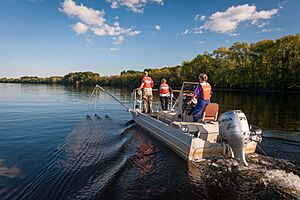
- Pollution Permits: The National Pollutant Discharge Elimination System (NPDES) program controls water pollution. It requires permits for businesses that release wastewater into U.S. waters. Most states manage this program.
- Water Quality Standards: They set standards for different water bodies, like rivers and lakes.
- Wetlands Protection: The EPA helps regulate activities that affect wetlands. They work with the U.S. Army Corps of Engineers to issue permits. Often, if wetlands are damaged, new ones must be created.
- Safe Drinking Water: The EPA makes sure our drinking water is safe. They set standards for over 148,000 public water systems. They work with states to enforce these standards.
- Funding for Water Projects: The EPA provides money to states for water projects. The Clean Water State Revolving Fund helps build wastewater treatment plants. The Drinking Water State Revolving Fund helps local drinking water systems.
Managing Land, Waste, and Cleanups
- Waste Management: The EPA regulates both regular trash (non-hazardous solid waste) and dangerous waste (hazardous waste). They set rules for landfills and how hazardous waste is handled. This includes tracking hazardous waste from where it's made to where it's disposed of.
- Cleaning Up Contaminated Sites: The "Superfund" program helps clean up sites that are highly polluted from past waste disposal. The EPA finds the parties responsible for the pollution and makes them pay for the cleanup. If no one can pay, the Superfund helps cover the costs.
- Oil Spill Prevention: The EPA has programs to prevent oil spills. They require facilities that store oil to have plans to prevent and control spills.
Controlling Chemicals
- Pesticide Regulation: The EPA checks, registers, and regularly reviews all pesticides sold in the U.S. They make sure pesticides are safe to use.
- Chemical Inventory: The EPA keeps a list of all existing chemicals used in the U.S. They also require companies to tell them about new chemicals before they are made.
- Toxic Release Inventory (TRI): This is a public resource where people can find out about toxic chemical releases from factories. This information helps communities make informed decisions.
Enforcing the Rules
The EPA has programs to enforce environmental laws. They can take legal action against those who break the rules. This includes civil and criminal cases. They also help businesses understand and follow the rules.
Other Important Programs
- EPA Safer Choice Label: This label helps people choose products with safer chemical ingredients. EPA scientists check every ingredient in these products.
- Energy Star Program: Started in 1992, this program encourages energy efficiency. You can find the Energy Star label on appliances, electronics, and even new homes. It has saved billions of dollars in energy costs.
- Smart Growth Program: This program helps communities plan their growth in ways that protect health and the environment. It aims to create good neighborhoods for everyone.
- Brownfields Program: This program gives money to local governments to clean up and reuse old, contaminated industrial sites (brownfields).
- Indoor Air Quality Tools for Schools: This program helps schools keep their indoor air healthy. It helps reduce things that can trigger asthma in students and staff.
- Environmental Education: The EPA works to teach people about the environment and how to protect it.
- Clean School Bus USA: This program aims to reduce pollution from school buses. It encourages stopping unnecessary idling and updating old buses.
- Green Chemistry Program: This program supports the creation of products and processes that use fewer hazardous chemicals.
- Beaches Program: This program helps monitor coastal waters and inform the public about water quality at beaches.
- Geographic Programs: The EPA has special programs for important water resources like the Chesapeake Bay Program and the Gulf of Mexico Program.
Images for kids
-
OSV Bold docked at Port Canaveral, Florida. This ship was used by the EPA for ocean and coastline studies.
More to Explore
- Environmental history of the United States
- Environmental policy of the United States
See also
 In Spanish: Agencia de Protección Ambiental de Estados Unidos para niños
In Spanish: Agencia de Protección Ambiental de Estados Unidos para niños


